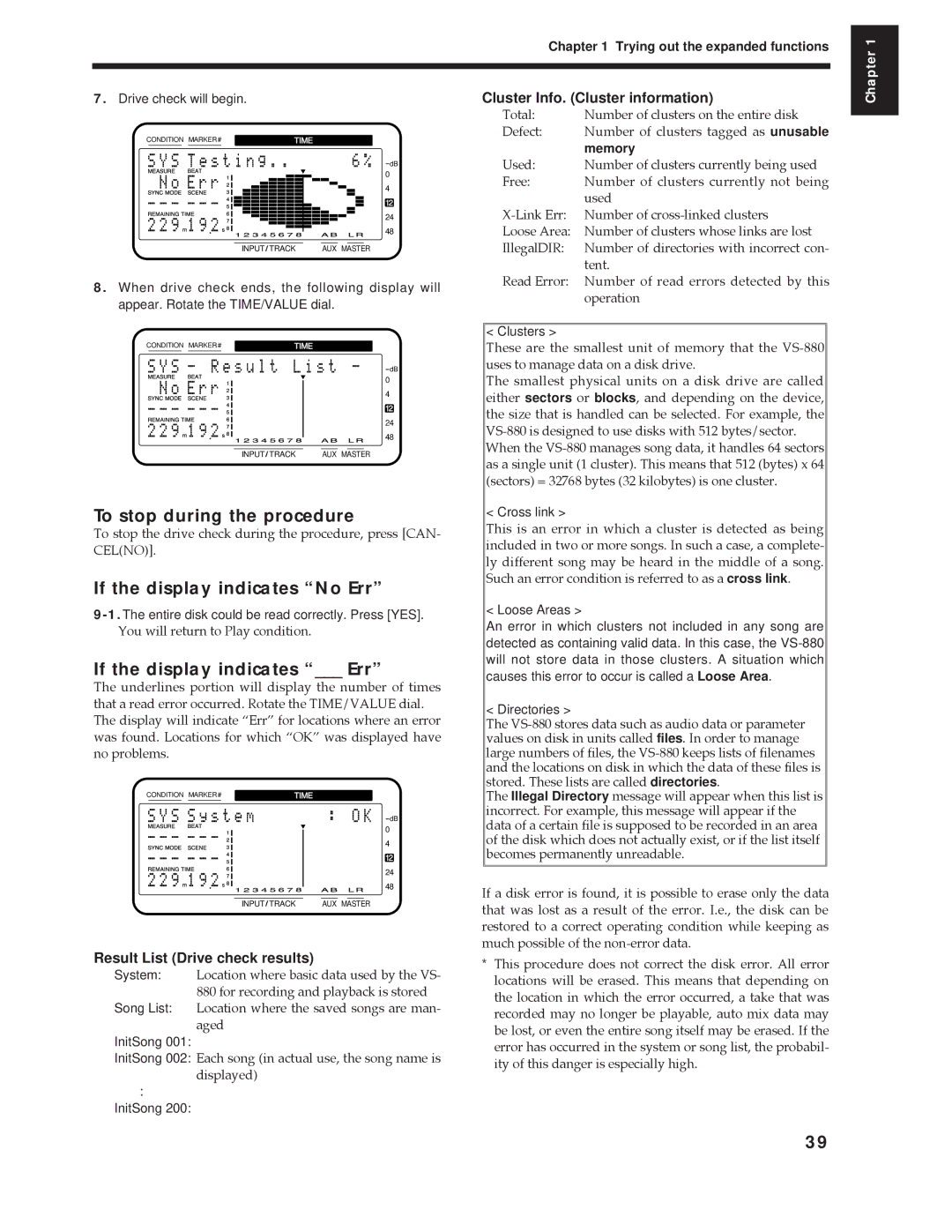
Chapter 1 Trying out the expanded functions
Chapter 1
7.Drive check will begin.
CONDITION MARKER# | TIME | ||||
|
|
|
|
|
|
dB
0
4
12
24
48
INPUT TRACK | AUX MASTER |
8.When drive check ends, the following display will appear. Rotate the TIME/VALUE dial.
CONDITION MARKER# | TIME | ||||
|
|
|
|
|
|
dB
0
4
12
24
48
INPUT TRACK | AUX MASTER |
To stop during the procedure
To stop the drive check during the procedure, press [CAN- CEL(NO)].
If the display indicates “No Err”
You will return to Play condition.
If the display indicates “___ Err”
The underlines portion will display the number of times that a read error occurred. Rotate the TIME/VALUE dial. The display will indicate ÒErrÓ for locations where an error was found. Locations for which ÒOKÓ was displayed have no problems.
CONDITION MARKER# | TIME | ||||
|
|
|
|
|
|
dB
0
4
12
24
48
INPUT TRACK | AUX MASTER |
Cluster Info. (Cluster information)
Total: | Number of clusters on the entire disk |
Defect: | Number of clusters tagged as unusable |
| memory |
Used: | Number of clusters currently being used |
Free: | Number of clusters currently not being |
| used |
Number of | |
Loose Area: | Number of clusters whose links are lost |
IllegalDIR: | Number of directories with incorrect con- |
| tent. |
Read Error: | Number of read errors detected by this |
| operation |
< Clusters >
These are the smallest unit of memory that the
The smallest physical units on a disk drive are called either sectors or blocks, and depending on the device, the size that is handled can be selected. For example, the
When the
< Cross link >
This is an error in which a cluster is detected as being included in two or more songs. In such a case, a complete- ly different song may be heard in the middle of a song. Such an error condition is referred to as a cross link.
< Loose Areas >
An error in which clusters not included in any song are detected as containing valid data. In this case, the
< Directories >
The
The Illegal Directory message will appear when this list is incorrect. For example, this message will appear if the data of a certain file is supposed to be recorded in an area of the disk which does not actually exist, or if the list itself becomes permanently unreadable.
If a disk error is found, it is possible to erase only the data that was lost as a result of the error. I.e., the disk can be restored to a correct operating condition while keeping as much possible of the
Result List (Drive check results)
System: Location where basic data used by the VS- 880 for recording and playback is stored
Song List: Location where the saved songs are man- aged
InitSong 001:
InitSong 002: Each song (in actual use, the song name is displayed)
:
InitSong 200:
*This procedure does not correct the disk error. All error locations will be erased. This means that depending on the location in which the error occurred, a take that was recorded may no longer be playable, auto mix data may be lost, or even the entire song itself may be erased. If the error has occurred in the system or song list, the probabil- ity of this danger is especially high.
39
